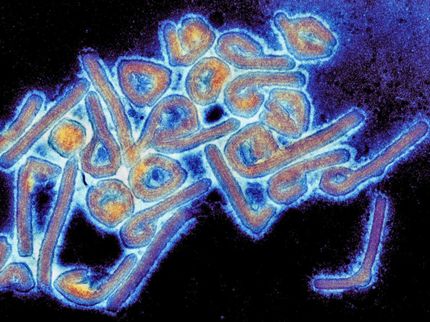CSIC study shows presence of monkeypox virus in air and saliva of infected patients
The work points to the possibility that the 'monkeypox virus' can also be transmitted by the airborne route
Advertisement
Research led by scientists from the Spanish National Research Council (CSIC) shows for the first time evidence of the presence of high amounts ofmonkeypox virus ( MPXV) in air and saliva samples from infected patients. The work, published in The Lancet Microbe, highlights the possibility that the virus can be transmitted by the airborne route, although direct contact, especially with skin lesions of an infected person, remains the dominant mode of transmission.

Monkeypox virus particles stained red.
Bruno Hernáez, CBMSO
The monkeypox virus, of the genus Orthopoxvirus, can be transmitted between animals and humans and the symptoms it causes are similar to those of smallpox, which was eradicated in 1980, although those of monkeypox are generally less severe, less transmissible and less lethal. The disease is endemic in Central and West Africa and is transmitted primarily by close contact.
In May 2022, a worldwide outbreak of monkeypox emerged and was declared a global health emergency by the World Health Organization (WHO). Months later, although the spread has slowed, the number of detected cases, which now stands at more than 79,000, already exceeds the total number of cases recorded in Africa since the virus was discovered in 1970. In Europe, as of November 8, there were about 25,400 confirmed cases, according to the European Centre for Disease Prevention and Control (ECDC), while in Spain, the outbreak has so far led to the confirmation of more than 7,300 cases.
"Epidemiological data suggest that the transmission of monkeypox virus takes place mainly by contact, but, in view of these new results, we propose not to dismiss and to monitor the possibility that it can also be transmitted through saliva microdroplets and by air," says Antonio Alcamí, CSIC researcher at the Severo Ochoa Molecular Biology Center (CBMSO-CSIC-UAM).
Infectious virus in saliva
In this study, the scientists analyzed saliva samples from 44 patients who, between May 18 and July 15, 2022, went to two health centers in Madrid (one of the regions with one of the highest incidences in the world) because they had skin lesions characteristic of the disease.
After analyzing the saliva samples, the researchers detected the presence of viral DNA in 85% of them. "Another relevant fact is that in 66% of the samples, the virus maintained its infectious capacity," adds Bruno Hernáez, researcher at CBMSO-CSIC-UAM.
The scientists detected the presence of the virus retained in most of the masks worn by the patients during the medical consultation. In addition, viral DNA present in the air was detected at a distance of between two and three meters from the patient, which was possible thanks to the use of nanofiber filters developed by the CSIC and the company Bioinicia, capable of capturing the virus.
"Thus, we were able to determine by PCR the presence of monkeypox virus in the air sampled during the medical visit of 64% of the patients in the study," says Alcamí, who emphasizes that, in this case, what they could not determine was the infectious capacity of the virus circulating in the air.
The results of this research, framed within the CSIC's Global Health Interdisciplinary Thematic Platform (PTI+ Global Health), have been obtained thanks to the involvement of teams from the Sandoval Health Center; the San Carlos Clinical University Hospital in Madrid; the Germans Trias i Pujol Research Institute in Badalona; the National Microbiology Center (ISCIII), and the Institute of Agrochemistry and Food Technology (IATA-CSIC).
Note: This article has been translated using a computer system without human intervention. LUMITOS offers these automatic translations to present a wider range of current news. Since this article has been translated with automatic translation, it is possible that it contains errors in vocabulary, syntax or grammar. The original article in Spanish can be found here.



























































